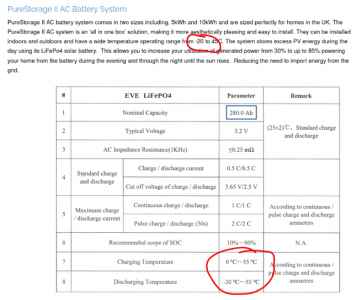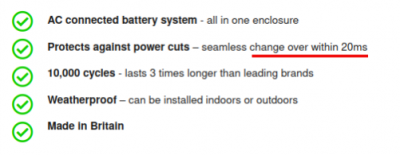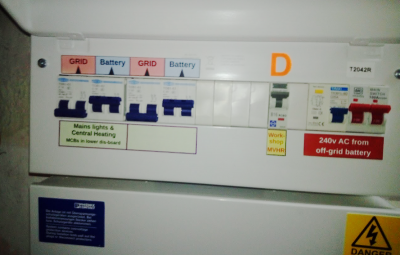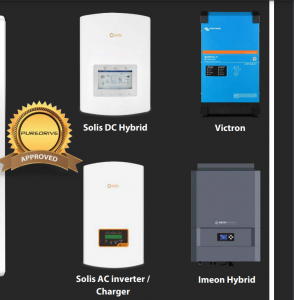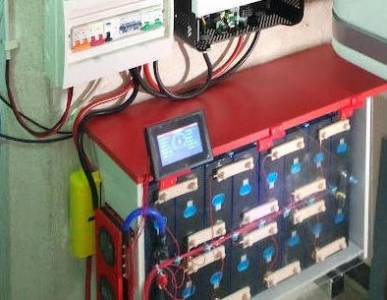Pure Drive Battery Storage System
Does anyone have any experience of knowledge of the Pure Drive battery solution?
https://puredrive-energy.co.uk/home-3/
I'm very attracted by many aspects of it, not least the fact it's made in UK and it's a lower comparable cost to similar offerings elsewhere. My only reservation is that they are a reasonably new company and there doesn't see to be much feedback on it either good or bad!
@squeakysim, I've 2 x 5kWh Puredrive (Purestorage II Hybrid) batteries coupled, via a Solis inverter, to a 5.6kW solar array. Can't offer a great deal of insight really, only installed in September so early days yet. I've no direct experience with Puredrive as all my follow-up has so far been with the system installer. No real issues - I was getting the odd 'battery management system' error code at first which was resolved by a firmware update.
2 x 12kW Samsung Gen6 ASHP, 5.6kW solar PV ground mounted c/w 10kWh Puredrive battery & Solis inverter.
I've screen-grabbed text from Pure Storage' own website, and present it here above the technical spec from EVE, a Chinese manufacturer of LiFePO4 cells:
When owners of caravans and RVs install LiFePO4 cells, they usually do so with a heater-plate below the stack of cells.
The BMS unit triggers the heater on once the temperature drops below zero.
It basically throws battery power at the problem
Do you think Pure Storage are using an internal heating plate within the cabinet?
Save energy... recycle electrons!
@transparent I've no cabinet covering my batteries so no, there's no internal heating. This limitation on charging when <0°C is a current discussion point though and my installer is responding on this.
2 x 12kW Samsung Gen6 ASHP, 5.6kW solar PV ground mounted c/w 10kWh Puredrive battery & Solis inverter.
I'm glad to hear that @dunlorn - unless you happen to know who manufactures the cells for Pure, we can't check their actual specs of course.
What about this bit, also snapped from Pure's website?
This feature has previously been attempted by other storage manufacturers, such as PowerVault. They withdrew it about 3 years ago.
It's tricky to power the house during a power-outage from two different viewpoints:
1: How does this system comply with G98 certification, such that electricity may not flow (export) onto the grid during a power cut - in order to protect the DNO engineers?
It's especially difficult for Pure to achieve this because their system is using 3rd-party hybrid inverters.
2: How does the Pure Storage system handle the switch-over if the current household demand is greater than it can sustain?
I can't see how it can provide off-grid power if cooker, oven, heat-pump and tumble-drier all happened to be active at the time the power went down.
Again, it's more usual for the 'decisions' about handling sudden power demands to be made by the hybrid inverter, not the logic which is incorporated in the battery unit(s).
A 20mS switch-over would suggest there's a mechanical contactor in the distribution board.
Do you have one?
Is this an optional extra?
BTW, I have a 'hybrid' house in which some circuits such as lighting, workshop, MVHR (ventilation) and central heating are powered permanently from battery storage.
So I have hands-on experience of what can work and what fails.
Save energy... recycle electrons!
Posted by: @transparent1: How does this system comply with G98 certification, such that electricity may not flow (export) onto the grid during a power cut - in order to protect the DNO engineers?
It's especially difficult for Pure to achieve this because their system is using 3rd-party hybrid inverters.
I'm not sure if that's why they only specific certain inverters to use with the battery maybe...?
There seems to be some discrepancies between the operating range in your screenshot, and the datasheet...!
The DC states operating temps: Discharge: -5°C to 60°C, Charge: 0°C to 55°C
The AC states operating temps: Discharge: -10°C to 60°C, Charge: -10°C to 55°C
The AC inverter states conditions of use as: Humidity 0 – 90%, Temperature -20°C to 60°C, Degressive power> 40°C
(15W/C)
Very confusing!! I even just found two datasheet versions for the DC model with conflicting data! I've sent them an email for clarification, and also included your questions too @transparent, so we'll see what they have to say!
@dunlorn was it a recommendation from the installer, or did you choose it for another reason?
Also, yours is the DC version yes?
I also came across this comment on solarguide.co.uk:
"1C rating
C-ratings show how quickly a battery can discharge the stored energy. A 1C rating means that the Puredrive Hybrid Battery can charge and discharge at the rate of the size of the battery without losing capacity. For example the 4.8kWh can charge and discharge at 4.8kW and still retain the full 4.8kWh capacity of the battery."
Does mean if you have a 10kW battery that what it can charge and discharge at...?!? Surely not?!!
@squeakysim The system was all specified by the installer. I did a bit of internet trawling research before committing, just to make sure nothing worrying emerged but really I was in their hands.
My main motivation was to be able to utilise much more of my PV generation, and battery use as any sort of emergency back-up wasn't at the forefront of my decision making. What I found hard was trying to establish what the 'optimum' size of battery installation was, given my forecast usage and PV yield, but this proved nigh on impossible. It's particularly difficult given PV yields are inversely related to my (ASHP) demand profile and that's before you even start to think about any smart tariff.
Intuitively, it seems 'bigger is better' when it comes to kWh storage but these units aren't cheap so there must be a sensible optimum. In the end I thought a single 5kWh unit would be too small and went for 2 units. I liked the modular aspect of the Puredrive and 10kWh seems like a good balance between daily PV yield (at least for 6 or so months of the year) and basic household consumption.
My installer is working on a fix to address the battery's inability to accept charge in freezing temperatures, which appears to have taken them by surprise. My PV yield is pretty tiny at this time of year but if I ever get on a smart tariff I want the ability to charge the battery in all weathers.
2 x 12kW Samsung Gen6 ASHP, 5.6kW solar PV ground mounted c/w 10kWh Puredrive battery & Solis inverter.
C-rating refers to the individual (3.2v) cells which are combined to build the battery.
16 such cells make a '48v' battery, which is what those four inverters are expecting to be connected to.
So if the internal cells are 105Ah, they can be charged at a maximum 105A. That's the 1C rating.
In practice you would design a battery system to stay well short of the theoretical 1C charge rate.
No design engineer wants to be working too close to a maximum parameter!
Here's a 16S configuration (16 cells in series) using 280Ah cells:
Using a quick 'back of envelope' bit of maths, a LiFePO4 battery with a capacity of 10KW would most likely be constructed from cells with a 200Ah specification.
Save energy... recycle electrons!
@squeakysim I'm far from an expert in this but what I've learned is that the rate at which batteries can accept charge (or discharge) is related to their state of charge and external factors like temperature. The capacity of your inverter also is a limiting factor. The battery management system works out what it should be accepting/discharging at a point in time. Occasionally I see the solis app telling me I'm exporting to grid when the battery is nowhere near full, which is a concern, but thankfully it only happens for short periods and makes a very small difference. I just think it's a function of varying yields/loads and the management system trying to keep up.
Oh, one other thing to be mindful of in confirming battery size is their usable capacity. Mine is 10kWh but in reality it's not quite 9 as the system is set to stop them discharging below 12%. Designed to safeguard battery life but means you have less than you think!
2 x 12kW Samsung Gen6 ASHP, 5.6kW solar PV ground mounted c/w 10kWh Puredrive battery & Solis inverter.
I have 20 kw of Puredrive storage, 4 x 5kw DC batteries linked to my Solis Hybrid inverter on a string of 4kw panels. I have an older 4 kw system too not tied into the batteries. Only had this set of panels since June 22 and the batteries since August 22. Up until the start of November, I was still getting enough PV to recharge the batteries and run all day and night. From the start of November charging at night on the cheap tariff and depending on the day the storage is lasting to early evening, some days it’s mid morning. Can’t really fault the system but only drawback is that the batteries will only charge and discharge at around 3 kw so periodically having to pull from the grid if the heatpump or air fryers are running. Looking forward to the spring and summer months to see what the system really does.
Can’t fault Solis or Puredrive customer services when I’ve called with minor issues.
- 26 Forums
- 2,342 Topics
- 53 K Posts
- 437 Online
- 6,000 Members
Join Us!
Worth Watching
Latest Posts
-
-
RE: External pipework insulation
Question the current insulation you see, does that look...
By jeegnesh , 1 hour ago
-
RE: Controlling Daikin Altherma via P1P2 and Home Assistant
@majordennisbloodnok That’s correct. I can’t find anywh...
By weoleyric , 6 hours ago
-
RE: Octopus Cosy Heat Pump Owners & Discussion Thread
@andrewj yeah we recreated it. Engineer seemed to think...
By swwils , 7 hours ago
-

RE: Configuring third party dongle for Ecodan local control
That's a good spot and a valuable insight, @sheriff-fat...
By Majordennisbloodnok , 10 hours ago
-

RE: Are We Sleepwalking Into Another Race to the Bottom?
@majordennisbloodnok And did ‘Honey’ order it for you? ...
By Toodles , 10 hours ago
-

RE: Setback savings - fact or fiction?
@robs — thanks again for your detailed comments. Some r...
By cathodeRay , 23 hours ago
-

RE: A Smarter Smart Controller from Homely?
@papahuhu I hope you get a swift resolution. Regards, T...
By Toodles , 1 day ago
-

RE: Poll for Time of Use, tariffs, technology
That’s fine by me too Major, I feel it is a sad reflect...
By Toodles , 1 day ago
-

Bingo. Sometimes a judiciously placed size 10 bovver bo...
By Majordennisbloodnok , 1 day ago
-
RE: Mitsubishi Ecodan 11.2kW heat pump with low COP
@ciocoiu-alexandru I can't provide the same level of di...
By Sheriff Fatman , 1 day ago
-

The three technical issues I'm considering are: BMS...
By Transparent , 1 day ago
-
RE: LiFePO4 lithium battery fires and explosions
@transparent Your post may fit better in th...
By Batpred , 1 day ago
-

RE: British Gas vs Octopus Energy vs Heat Geek vs EDF vs Aira vs OVO vs EON.Next vs Boxt
@jamespawhite, if you could be bothered, you could also...
By Mars , 1 day ago
-
RE: Commencing on an ASHP Installation Process
I've got a bit of time to draft something today, so the...
By Sheriff Fatman , 2 days ago
-
RE: Help with heat pump sizing
@amin I dont think materially relative to t...
By JamesPa , 2 days ago
-

@majordennisbloodnok I have decided to take the plunge....
By TechnoGeek , 2 days ago
-
RE: Different dT on each radiator?
I cant sorry. Its based on some calculations I did fro...
By JamesPa , 3 days ago

